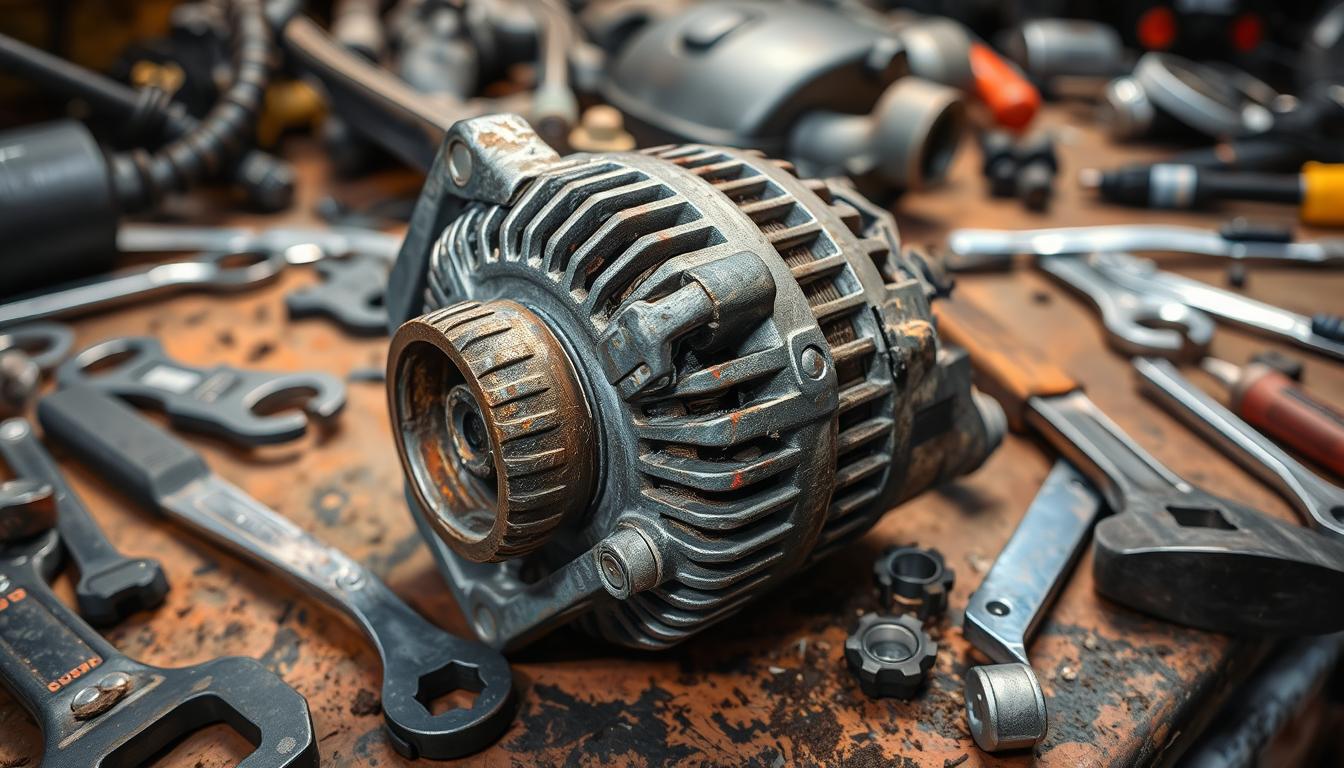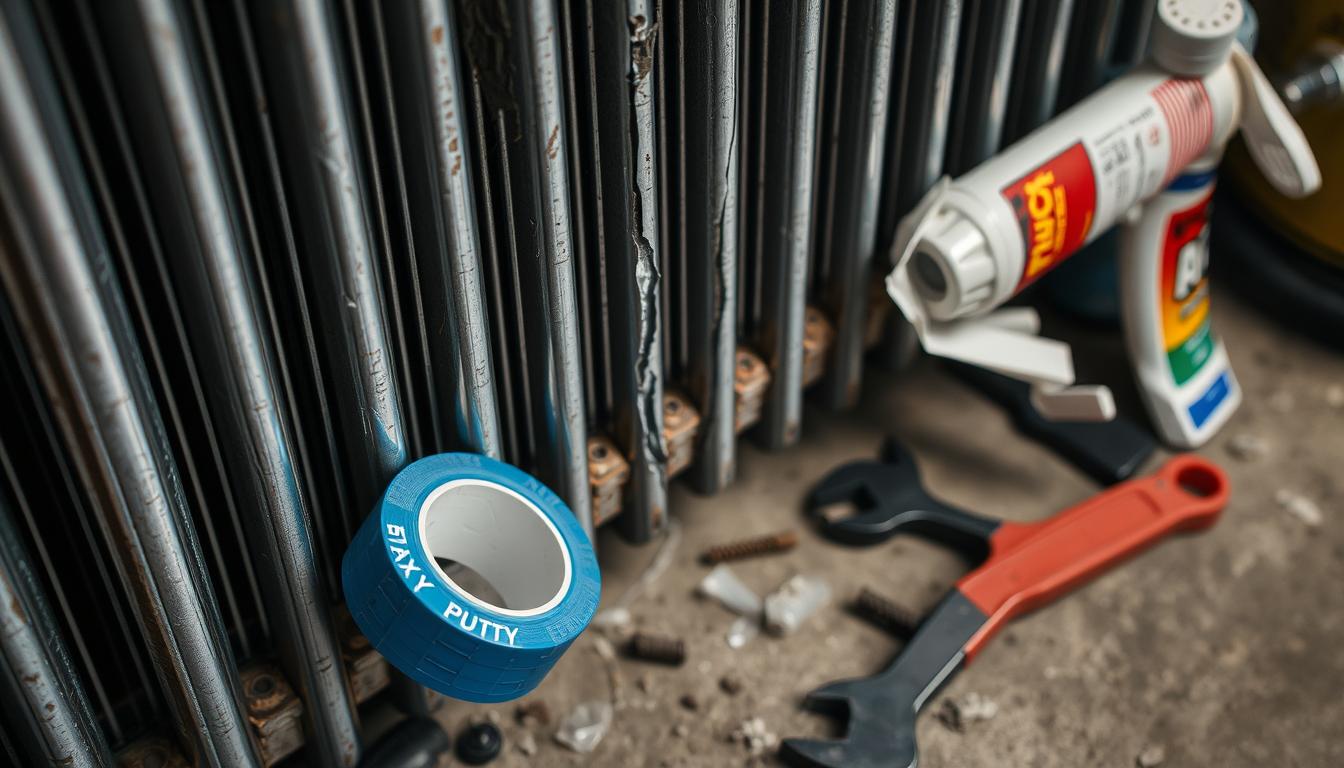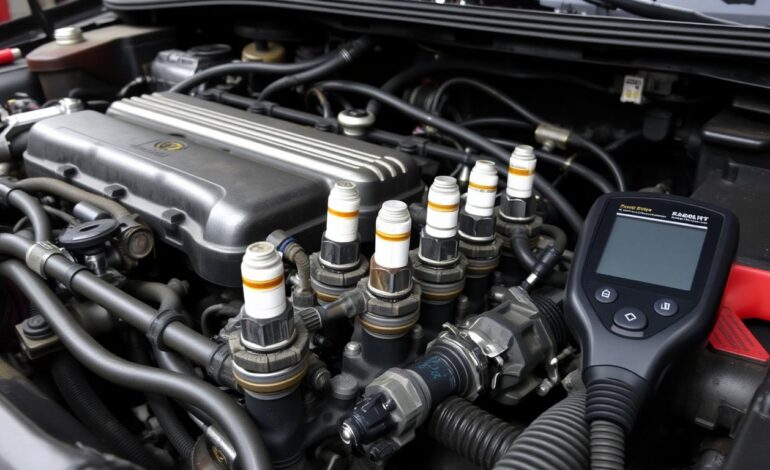
Diagnosing and Fixing Common Engine Misfire Issues
Engine misfires can be a source of frustration and expense for car owners. They happen when the engine’s combustion process is disrupted, leading to reduced power and efficiency. It’s vital to grasp the science behind engine combustion and how misfires impact performance for effective diagnostics. Advanced tools and techniques help identify and fix misfire issues, preventing further damage and ensuring peak vehicle performance.
Various factors can cause engine misfires, such as faulty spark plugs, ignition system malfunctions, and fuel system problems. Regular diagnostics and maintenance can prevent misfires, keeping vehicles running smoothly and efficiently. By tackling misfire issues promptly, individuals can save time, money, and extend their vehicle’s lifespan.
Key Takeaways
- Engine misfires can cause a loss of power and efficiency in vehicles
- Understanding the science behind engine combustion is vital for effective diagnostics
- Advanced diagnostics tools and techniques help identify and address misfire issues
- Regular maintenance prevents misfires and ensures optimal vehicle performance
- Engine diagnostics is essential for identifying and addressing misfire issues
- Addressing misfire issues extends a vehicle’s life and saves time and money
Understanding Engine Misfires: What They Are and Why They Matter
Engine misfires can be a source of frustration and potentially harm your vehicle. It’s vital to grasp how engines function and what misfires signify. Engine diagnostics are key in pinpointing the cause of these issues. A misfire happens when the fuel-air mix in the engine’s cylinders fails to ignite, causing power loss and reduced efficiency.
The combustion process in engines is intricately complex. It involves fuel, air, and spark to generate energy. Any disruption in this process can lead to misfire troubleshooting challenges. Common signs include rough idling, decreased performance, and the check engine light turning on.
The Science Behind Engine Combustion
Combustion in engines requires a precise balance of fuel, air, and spark. Any imbalance can cause misfires. Engine diagnostics tools are essential in pinpointing issues with the fuel, ignition systems, or other components.
How Misfires Affect Vehicle Performance
Misfires significantly impact vehicle performance, leading to decreased power, reduced fuel efficiency, and engine damage. Misfire troubleshooting is critical to find and fix the root cause. Misfires can result in:
- Decreased power and acceleration
- Reduced fuel efficiency
- Potential damage to the engine and other components
Signs of a Misfiring Engine
Recognizing the signs of a misfiring engine is essential for timely action. Common indicators include:
- Rough idling
- Decreased performance
- Check engine light illumination
Understanding engine combustion and misfire effects empowers vehicle owners to tackle the issue. Engine diagnostics and misfire troubleshooting are vital for resolving engine misfire problems.
Common Symptoms That Signal an Engine Misfire
Dealing with an engine misfire can be both frustrating and costly. It’s vital to recognize the signs of an engine misfire to avoid more damage and keep your vehicle running well. Common symptoms include rough idling, stumbling when accelerating, and a drop in fuel efficiency.
A noticeable decrease in fuel efficiency often points to an engine misfire. This can result in higher fuel use and emissions. To find the cause, performing thorough engine diagnostics is key. This involves using advanced tools to analyze the engine’s performance and locate the issue.
- Rough or uneven engine performance
- Decreased power and acceleration
- Increased emissions and fuel consumption
- Engine warning lights or codes on the dashboard
Spotting these symptoms early and acting quickly can prevent engine damage. Whether it’s a minor or major issue, getting professional help is essential. They can help repair engine problems and get your vehicle back in top shape.
The Most Common Causes of Engine Misfires
Engine misfires can be frustrating and challenging to diagnose. Understanding the underlying causes is essential. Engine diagnostics play a key role in identifying the root cause. Through thorough misfire troubleshooting, you can pinpoint whether the issue is in the ignition system, fuel system, or other components.
Some common causes of engine misfires include:
- Faulty spark plugs or ignition coils
- Fuel system problems, such as clogged fuel injectors or a faulty fuel pump
- Mechanical component failures, including worn-out piston rings or cylinder walls
- Sensor and computer-related issues, such as a malfunctioning oxygen sensor or engine control module
Advanced engine diagnostics tools and techniques help quickly identify the misfire cause. This may involve replacing faulty components, cleaning or repairing the fuel system, or reprogramming the engine control module. Effective misfire troubleshooting is critical to prevent further engine damage and ensure optimal performance.
Using Modern Diagnostic Tools to Identify Misfires
In the realm of engine diagnostics, the right tools are essential. Modern diagnostic tools, like code readers and scan tools, are vital for pinpointing misfire causes. They enable technicians to efficiently diagnose and repair engines, cutting down on time and costs.
Key diagnostic tools for misfire detection include:
- Code readers: These tools read trouble codes from the vehicle’s onboard computer, shedding light on misfire causes.
- Scan tools: They offer real-time engine performance data, including engine speed, fuel trim, and ignition timing.
- Oscilloscopes: These tools display ignition system waveforms, aiding in the identification of spark plug or ignition coil issues.
Utilizing these advanced tools, technicians can swiftly pinpoint misfire causes. This leads to quicker and more precise repair engine work. It not only saves time and money but also ensures the vehicle operates safely and efficiently.
| Diagnostic Tool | Description |
|---|---|
| Code Reader | Reads trouble codes stored in the vehicle’s onboard computer |
| Scan Tool | Provides real-time data on engine performance |
| Oscilloscope | Visualizes the waveform of the ignition system |
Step-by-Step Diagnostic Process for Engine Misfires
Diagnosing engine misfires requires a detailed and systematic approach. It involves the use of advanced diagnostic tools and techniques to pinpoint the root cause. This section will guide you through the diagnostic process, including visual inspections, electronic diagnostics, and compression testing.
Visual Inspection Techniques
The first step in engine diagnostics is a visual inspection. This involves examining the engine and its components for any signs of wear or damage. Look out for:
- Worn or damaged spark plugs
- Cracked or broken ignition coils
- Leaks in the fuel system
Electronic Diagnostic Methods
Electronic diagnostics use specialized tools to analyze the engine’s performance. This includes checking for trouble codes with a code reader and monitoring engine performance with a scan tool.
Compression Testing
Compression testing is a critical step in misfire troubleshooting. It measures the compression in each cylinder to identify issues with the engine’s compression system. By following these steps and using the right tools, you can quickly identify the cause of an engine misfire and get back on the road.
| Diagnostic Method | Description |
|---|---|
| Visual Inspection | Checking the engine and its components for signs of wear or damage |
| Electronic Diagnostic Methods | Using specialized tools to analyze the engine’s performance and identify problems |
| Compression Testing | Measuring the compression in each cylinder to identify problems with the engine’s compression system |
Essential Tools and Equipment for Misfire Repair
To repair engine misfires effectively, having the right tools and equipment is key. A spark plug socket is essential for removing and installing spark plugs, often the cause of misfires. An ignition system tester aids in diagnosing ignition system problems. Lastly, fuel system cleaning equipment is vital for clearing blockages or debris in the fuel system.
When selecting tools, consider the following:
- Spark plug sockets: Choose durable ones that can handle high torque.
- Ignition system testers: Select ones that can identify a variety of ignition system issues.
- Fuel system cleaning equipment: Ensure it’s designed for your vehicle’s make and model.
A well-stocked toolbox is essential for engine misfire repair. Investing in high-quality tools ensures a successful 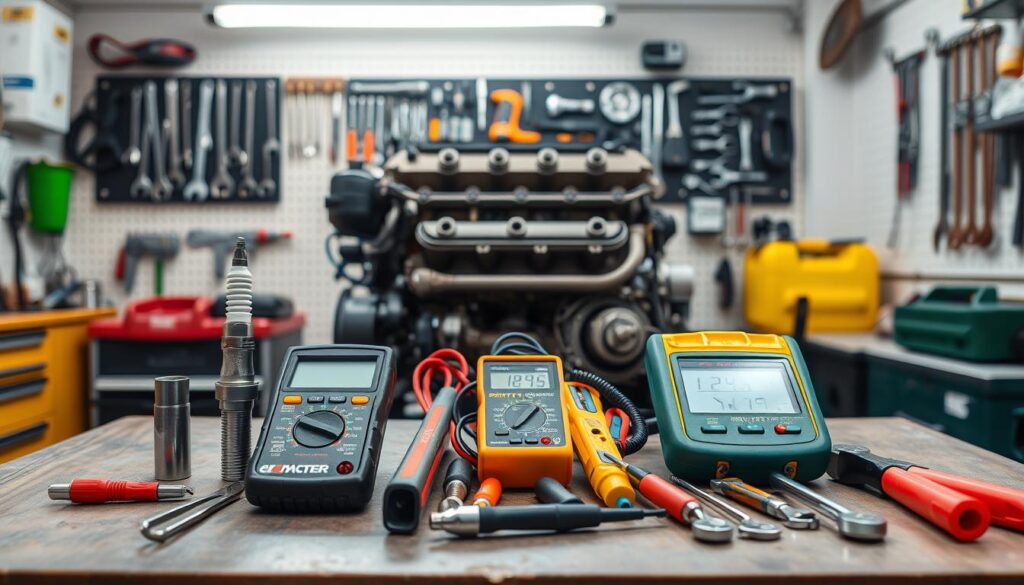
Having the right tools is just the beginning. It’s also vital to follow proper repair procedures and take necessary safety precautions. This way, you can avoid further damage to your vehicle. With the right tools and some knowledge, you can repair engine misfires and keep your vehicle running smoothly.
| Tool | Description |
|---|---|
| Spark Plug Socket | Used to remove and install spark plugs |
| Ignition System Tester | Diagnoses issues with the ignition system |
| Fuel System Cleaning Equipment | Cleans out blockages and debris in the fuel system |
DIY Repair Solutions for Common Misfire Problems
Identifying the root cause of a misfire is key to effective repair. Misfire troubleshooting can seem daunting, but with the right tools and knowledge, DIY repairs can save you money and empower you. Getting your vehicle back on the road becomes a more achievable goal.
A well-maintained engine is less prone to misfires. Regular checks can spot issues before they escalate. By following proper diagnostics and using the right tools, you can tackle common misfire problems like faulty spark plugs or ignition coil issues.
Spark Plug Replacement Guide
Replacing spark plugs is a simple task that can be done at home. It’s vital to follow safety precautions and procedures to avoid engine damage or injury. Key steps include:
- Locating the spark plugs and removing any necessary components to access them
- Using a spark plug socket to remove the old spark plugs
- Installing new spark plugs and tightening them to the recommended torque specification
Ignition Coil Testing and Replacement
Ignition coil issues can also lead to misfires. Testing and replacing them requires the right tools and knowledge. Key considerations include:
- Using a multimeter to test the ignition coil’s resistance and voltage output
- Checking for any signs of physical damage or wear on the ignition coil
- Replacing the ignition coil with a new one and ensuring it’s properly connected and secured
By following these DIY repair solutions and maintaining your vehicle regularly, you can prevent future misfires. Always prioritize safety when working with engine diagnostics and misfire troubleshooting.
When to Seek Professional Help for Engine Misfires
Diagnosing and fixing engine misfires can be a daunting task, often requiring advanced skills. If you’re facing persistent engine misfires, it’s time to seek professional assistance. A skilled mechanic can pinpoint the misfire’s source and perform the necessary repairs. This ensures your vehicle operates smoothly.
Engine misfires can stem from various complex factors, making diagnosis and repair tricky. A professional mechanic brings specialized tools and knowledge to the table. They can tackle scenarios like:
- Intermittent misfires that only occur under specific driving conditions
- Misfires triggered by multiple factors, such as ignition and fuel system issues
- Misfires needing specialized equipment for diagnosis, like scan tools and compression testers
When considering professional help, the cost of repairs is a critical factor. While DIY fixes can save money, complex issues often require specialized tools and expertise. It’s wise to compare prices and find a reputable mechanic who offers affordable solutions.
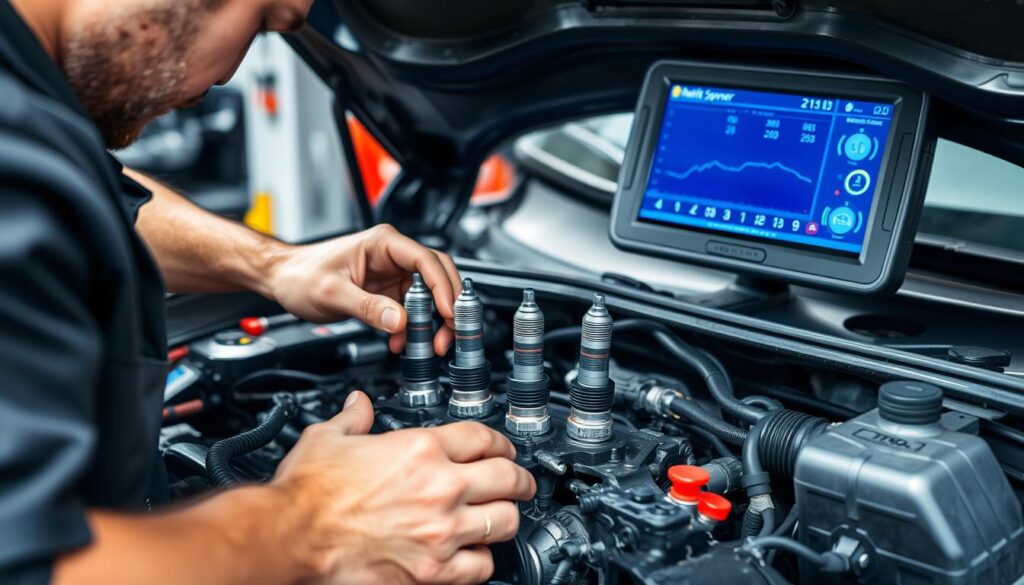
Seeking professional help ensures your vehicle is thoroughly diagnosed and repaired. This approach saves you time and money in the long run. Always prioritize your safety and the safety of others by addressing engine misfires promptly. Professional assistance is key to resolving engine issues and preventing further damage.
Preventing Future Engine Misfires Through Proper Maintenance
Regular maintenance is essential to avoid future engine misfires. By integrating engine diagnostics into your routine, you can spot issues early. This includes monitoring your vehicle’s performance, checking for error codes, and replacing spark plugs and cleaning the fuel system regularly.
To create a maintenance schedule that suits your vehicle and budget, consider these tips:
- Refer to your owner’s manual for maintenance intervals
- Track your vehicle’s mileage and performance
- Regularly check your spark plugs, fuel system, and ignition system
By maintaining your vehicle, you can lower the chance of misfire troubleshooting and ensure your engine runs smoothly. Remember, prevention is always better than repair.
Regular maintenance also offers other benefits:
- It improves fuel efficiency
- Increases engine performance
- Reduces the risk of breakdowns
By focusing on maintenance and using engine diagnostics regularly, you can maintain a well-running engine and prevent future misfires. Regular misfire troubleshooting helps catch issues early, saving you time and money.
Conclusion: Taking Control of Engine Misfire Issues
Understanding and addressing engine misfires is vital for your vehicle’s performance and longevity. Knowing the common engine misfire symptoms, causes, and diagnostic methods allows you to act early. This proactive approach can prevent more severe and expensive issues.
Regularly checking your spark plugs, ignition system, and fuel system is essential. Addressing any problems quickly can help prevent future misfires. Keeping up with the latest diagnostic tools and methods also empowers you. This way, you can handle minor repairs yourself or seek professional help when needed.
A well-maintained engine ensures a smooth, reliable, and efficient driving experience. Following the advice in this article helps keep your engine in top condition. This way, you avoid the frustration and dangers of engine misfires.




